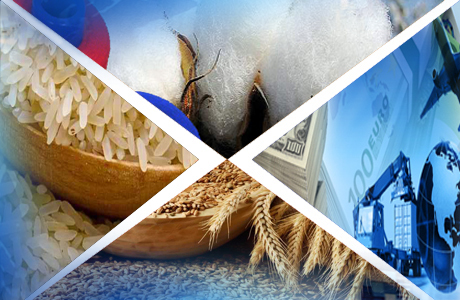Trade numbers: the fruits of
overvalued currency
By: BR Research
 Are
we really benefiting from the low commodity price era?
Are
we really benefiting from the low commodity price era?
A glimpse of trade data is
showing a rather widening deficit.
In Jul-Feb, exports were
down by 5 percent while imports were up by 4 percent.
Thus the gap increased by
16 percent to $12.5 billion in first eight months of the
current fiscal.
The situation worsened in
February as, on monthly basis, exports fell by 9 percent
while the imports increased by the same percentage to widen
the gap by 46 percent.
With this, the hopes of a
current account surplus in 2HFY15 are fading away and the
full year deficit may cross $2 billion.
Yet home remittances grew by
15 percent in Jul-Feb to reach $11.75 billion, thus taming
the current account deficit albeit not enough to completely
plug the trade gap.
One may wonder what is happening on the trade front. Is high
deficit in February a one-off event? Or oil prices to blame,
as on average these are up by 20 percent from multi-year low
in January.
Or is the steep depreciation
of the Euro hitting exports of made-up textiles to Europe?
To get answers we need to wait for the detailed numbers.
Whatsoever the reason, the detailed numbers for seven months
(Jul-Jan) are not establishing any encouraging trend as the
trade deficit on annual basis was down by 18 percent.
The devil lies in the
details. Imports were up by 6 percent or $1.4 billion in
Jul-Jan despite the fact, oil imports were down by 14
percent or $1.2 billion. This means all other imports were
up by 20 percent or $2.7 billion.
What is going on? Why are the
imports on such a high trajectory? Is currency overvalued to
make imports cheaper? Is domestic production on a decline?
What is the policy response to check this rising imports
trend?.
Further analysis depict a
rather sorry state - food imports of an agrarian economy
grew by 31 percent despite the fact palm oil (essential
item) imports did not grow at all, thanks to 20 percent fall
in international prices.
Why are we importing wheat
when there are surplus stocks and a bumper crop in the
offing? We have imported around 0.7 million tons of wheat in
Jul-Jan to take the import tally to $185 million.
The imports of milk products
increased by $78 million. Is this the fate of the fifth
largest milk producing country of the world?
Similarly the import growth of tea, spices and pulses is in
the range of 22-36 percent. Are we all of a sudden consuming
more considering that tea imports are up by 30 percent?
Other food imports are up by
78 percent, reaching $1.2 billion.
Did the people lose trust in
local produce overnight or has domestic production slumped
suddenly? Mind you, growth in food items is restricted owing
to the low global prices.
Had the prices remained at
last years level, the growth would have been much higher.
This is exactly what happens when the economic managers keep
local currency artificially high.
Machinery imports were up by
16 percent in Jul-Jan to reach $4.2 billion. The immediate
response is to jubilate as this may translate into future
growth of exports.
However, that not might be
the case as imports in textile machinery is on a decline.
The power generating machinery is on the rise - that may be
to plug in the gap in energy supply and demand.
Office related machinery is
up - as probably more businesses are coming up. There is
some growth in telecom apparatus which might be due to
operators efforts to enhance 3G/4G/LTE coverage.
There is growth in iron and
steel by 48 percent which might be explaining government's
love with roads and building infrastructure. Not bad, higher
construction activities may result in more jobs.
On export front, the overall number was down by 4 percent in
the Jul-Jan period. In the food category, rice exports
stagnated, while fruits and vegetables are marginally down.
There is ample room in this
segment to grow and government ought to devise policies to
spur it.
In textile, the growth in
knitwear, readymade garments and towels (thanks to GSP plus
status) was completely offset by the fall in cotton yarn and
cotton cloth (owing to low global demand and falling
prices).
In a nutshell, textile
exports are up by mere one percent to reach $8.1 billion in
the period under review.
The worrisome fact is the fall in other manufacturing groups
exports by 15 percent to $2.3 billion. The worrisome stats
are in the other items of exports which are down by 10
percent to $762 million.
The overall trade data is calling out for policy measures to
spur exports and curb imports. The best way is to let the
currency find its real value; but given Dar's love for
overvalued currency, one may rule out this option.
The other instrument is to
have regulatory duty on non-essential imports - the
government has done so and that might put a knuckle of
imports growth in months to come.
But what about exports? How
to boost them? Apparently, the finance and commerce
ministries have no answer.
==================================================================
Key trade numbers
==================================================================
Export Group
7MFY15 chg
Import Group
7MFY15 chg
==================================================================
Total
14677 -4%
Total
25808
6%
food
2657
-4%
Food
2410
31%
textile
8016
1% Machinery
group 3634
16%
other man gr
2697 -15%
Petroleum
8735 -14%
other
820
-7%
metal
1658
26%
other imports
2186
12%
==================================================================
March, 2015
Source: Business
Recorder